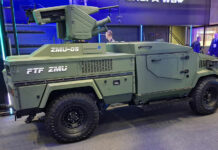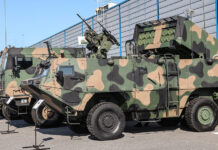Unmanned Systems at DSEi 07: Among the unmanned systems on display, defense Update picked few of the innovations, displayed at the Harris stand by Dragonfly pictures. Other systems were shown by MacroSwiss and Selex. The later is aggressively marketing several new UAV systems developed under cooperation with the Italian Unmanned Technologies Research Institute (UTRI) and Alpi Aviation. All three platforms are designed for field operation by lower echelon field units, offering ‘over the hill’ and ’round the corner’ intelligence in direct support for combat operations. Another VTUAV is the Damselfly, developed by Selex Sensors & Airborne Systems in the UK. Vertical Take Off and Landing (VTOL) Unmanned Air Vehicle (VTUAV) is developed by the company by internal funding. This platform is envisioned as suitable for land and naval operations.
A novel design of an unmanned aerial vehicle, utilizing tandem rotor configuration was introduced by Dragonfly Pictures. The company displayed at DSEi 07 its electrically powered DP-6 Whisper tandem rotorcraft, as part of a comprehensive border surveillance systems solution provided by Harris. The main advantage of this unique design is the low acoustic signature associated with the electrical propulsion and tandem rotor design, enabling the Whisper to remain stealthy, particularly at night and over densely forested or urban terrain.
Selex is marketing several new UAV systems developed under cooperation with the Italian Unmanned Technologies Research Institute (UTRI) and Alpi Aviation. All three platforms are designed for field operation by lower echelon field units, offering ‘over the hill’ and ’round the corner’ intelligence in direct support for combat operations. Another VTUAV is the Damselfly, developed by Selex Sensors & Airborne Systems in the UK. Vertical Take Off and Landing (VTOL) Unmanned Air Vehicle (VTUAV) is developed by the company by internal funding. This platform is envisioned as suitable for land and naval operations.
 OTUS, a hand launched mini UAV is designed to provide ‘over the hill’ intelligence and improve situational awareness for the lower echelon. The UAV is carried in a backpack, assembled within 10 minutes and can operate for over 60 minutes at a range of about 10 km from the launching point, flying at speeds of 15 – 45 knots. The UAV weighs about 8 kg (GTWO) and carries a maximum payload of one kilogram.
OTUS, a hand launched mini UAV is designed to provide ‘over the hill’ intelligence and improve situational awareness for the lower echelon. The UAV is carried in a backpack, assembled within 10 minutes and can operate for over 60 minutes at a range of about 10 km from the launching point, flying at speeds of 15 – 45 knots. The UAV weighs about 8 kg (GTWO) and carries a maximum payload of one kilogram.
Another product developed under the UTRI cooperation is the ASIO – a mini Vertical Take Off and Landing (VTOL) UAV is a fully automatic, electrically powered VTUAV designed primarily for ‘hover and stare’ battlefield surveillance; forward scout missions and special operations mission support. The ASIO is controlled by a ruggedized common ground control unit carried in a backpack, used for all Selex’ new mini UAVs. An ASIO system including one VTUAV, two camera payloads (day/night or uncooled infrared) and a ground control system weighs around 20 kg. The ASIO weighs 4 kg and carries a payload weighing 500 gram. ASIO can be assembled and prepared for a mission within 10 minutes. Mission endurance is about 40 minutes, operating at speeds of 0 – 25 kt within 10 km from the launching point.
Under a parallel cooperation with the Italian Alpi Aviation, Selex is offering the Strix man-portable aerial vehicle designed for extended operation – in both range, end mission endurance. This Electrically powered flying wing has a span of three meters. Endurance is extended to 90 minutes at an optimal cruise speed of 40 knots. The entire system, comprising an aerial vehicle, three camera payloads, and ground control station is packed into a single backpack weighing 20 kg.
Another VTUAV from Selex is the Damselfly, developed by Selex Sensors & Airborne Systems in the UK. Vertical Take Off and Landing (VTOL) Unmanned Air Vehicle (VTUAV) is developed by the company by internal funding. It demonstrates a unique propulsion system based on a high speed fan coupled to four independently controlled directional nozzles for thrust dispersal. Each nozzle has steerable vanes adding control trim for improved station-keeping and maneuverability. The independently movable are controlled by the flight control system to achieve controlled hovering and transit to forward flight. This propulsion system offers more versatile and survivable operation at low altitude and over cluttered terrain (forest, jungle, ship deck).
Lightweight Synthetic Aperture Radar called PicoSAR, designed for UAVs was displayed here by Selex. Weighing only 10 kg, significantly lower than most alternatives, the new X-band radar has a range of 20 km. It offers a broad area or ‘spotlight’ coverage, with typical 1 meter resolution, and the ability to spot moving targets through Ground Moving Target Indication (GMTI) mode. Selex plans to test the new radar on UAVs in 2008.

The Swiss company MarcoSwiss unveiled at DSEi 07 the latest and smallest member of the SpyRobot 4WD family of unmanned Ground Vehicles. Like its bigger brothers, the new Micro Spyrobot 4WDcan be operated by a single person, be thrown through a window, up to or from a second floor, and provide real-time imagery from interiors which could pose a risk to the forces. Measuring only 20cm x 20cm, the robot weighs about one kilogram, carrying two high resolution day/night electro-optical cameras and communications gear. The vehicle uses a special traction mechanism, comprising the ‘flapper wheel’ design, contributing to high speed road, off-road and swimming mobility and effective obstacle negotiation. The robot can climb 45 degree slopes characteristic with rough and rugged terrain. The Micro SpyRobot 4WD can be carried with standard modular load carrying equipment (MOLLE) and is suitable for operation by dismounted troops and special forces.
The larger (5 kg) SpyRobot 4WD UGV is suitable for operations associated with base vehicle support. The SpyRobot is powered by rechargeable lithium polymer batteries sustaining up to eight hours of continuous movement. Sofar MacroSwiss sold the SpyRobot 4WD to customers in the UK, US, Norway and Germany. India, Canada and Singapore expressed interest in the system. The Micro SpyRobot 4WD is also raising significant interest. According to MacroSwiss, the British MoD has acquired the first micro SpyRobot 4WD while the US DoD has down selected it as one of two candidates for evaluation to fulfill a large requirement to equip the 1st Special Forces Group.
Another product launched by MacroSwiss is reviving the World War I trench periscope concept, with 21st century technology. ‘Advanced Combat Camera System (ACCS), an evolutionary improvement of the Giraffe pole camera system, currently in service with the US Marine Corps follows the simple ‘camera on a stick’ solution. ACCS comprises a zoom, daylight color TV camera or a low-light or thermal sensors for night operation coupled with a digital video recorder for intelligence gathering. According to Barry ET Harris, Director of Sales & Marketing at MacroSwiss, the system is particularly effective at close quarter combat situations, in built-up environment where “it has the potential to make the difference between winning and losing”. Camera on a stick type of sensor was tested by Thales UK and the British Army, as part of the FIST system evaluation.
Carl Zeiss develops New Gear for Snipers
Carl Zeiss Optronics unveiled here a prototype of its handheld surveillance and reconnaissance system called Opus-H. This integrated system comprises an uncooled IR and visual channels, a laser rangefinder, a digital magnetic compass and a GPS receiver in a single lightweight package weighing less than three kilograms. The system will be useful for reconnaissance, target acquisition and command & control. Another innovation from Carl Zeiss is aimed at marksmen and snipers, for which the company developed the Sniper Auxiliary Attachment (SAM) module for the 6-24 x 72 telescopic sights. The attachment will provide marksmen to receive critical information without taking their eyes off the target. SAM enables marksmen to receive information while maintain his sight on target. At the touch of a button, they can access information from sensors, rangefinders and setting of the aiming devices, easily determining information on elevation, azimuth settings, temperature and air pressure.
IMC Provides Panoramic, Immersive Vision
Another provider of panoramic vision technology is Immersive Media Corp. (IMC) offering 360 degree vision systems for ‘geoimmersive’ surveillance, mapping, training and situational awareness systems. At DSEi 07 the company emphasized their training applications, providing ‘immersive vision’ for surveillance, post-exercise analysis ad operational pre-planning rehearsal. This unique technology is based on IMC’s proprietary ‘Dodeca’ vision system – a 12-sided, dodecahedron shape camera. The system feeds video to be integrated with digital maps,3D models or aerial photos to simultaneously display fully panoramic vision – 360 degrees lateral and 290 degrees in elevation, showing an interior view inside buildings as well an area under surveillance in an open area. Each object is geo-referenced in space, providing the viewer with accurate positioning and situational awareness. Users can interface with the system via head mounted displays or flat screens.

















